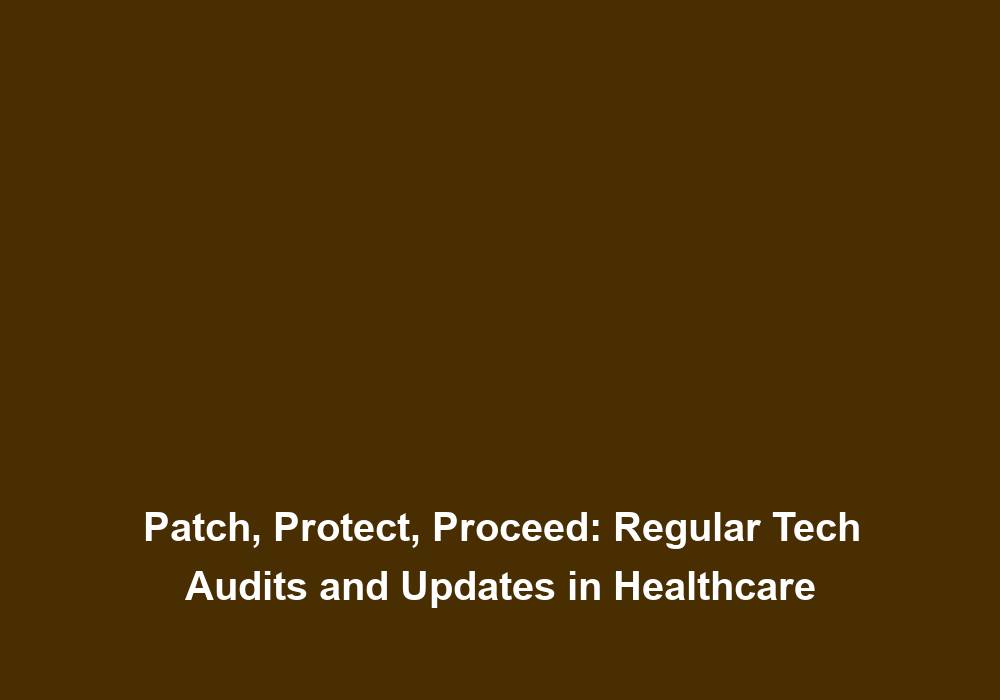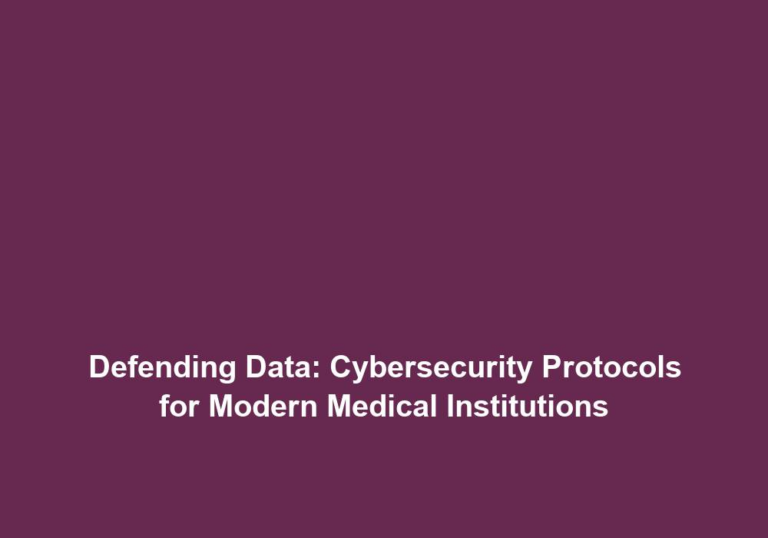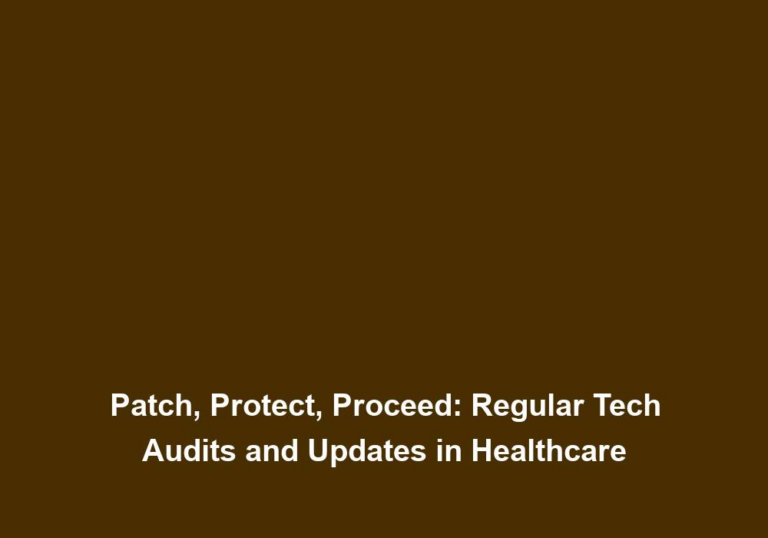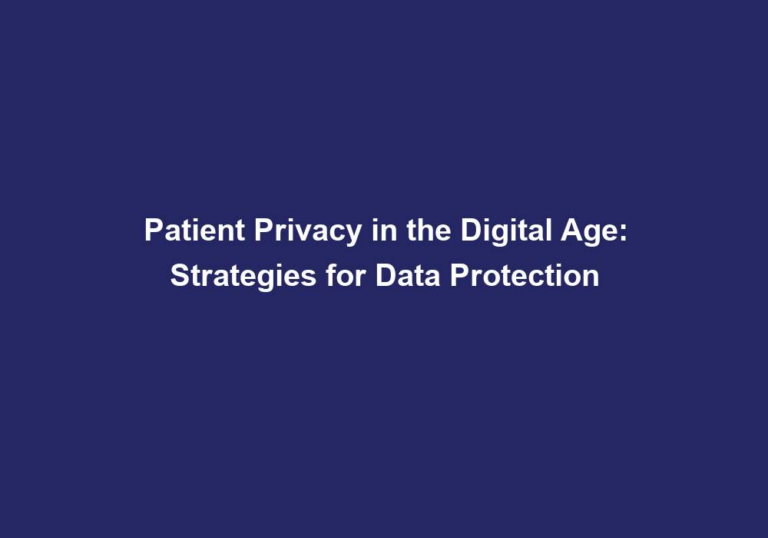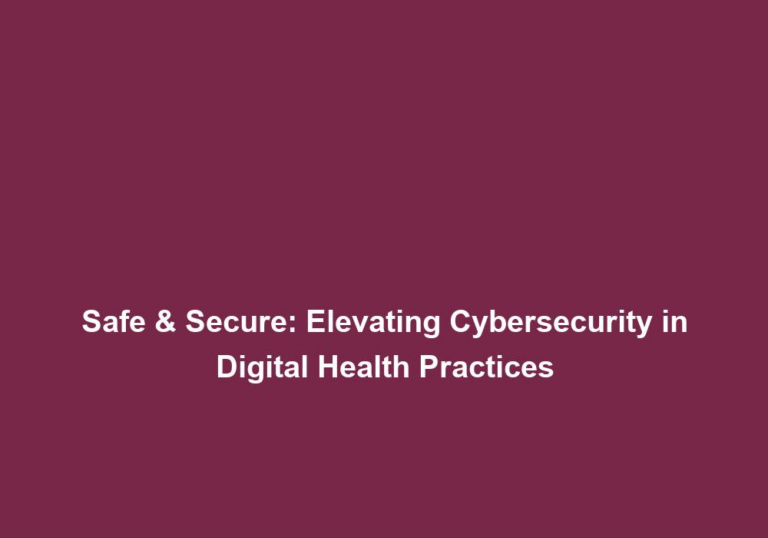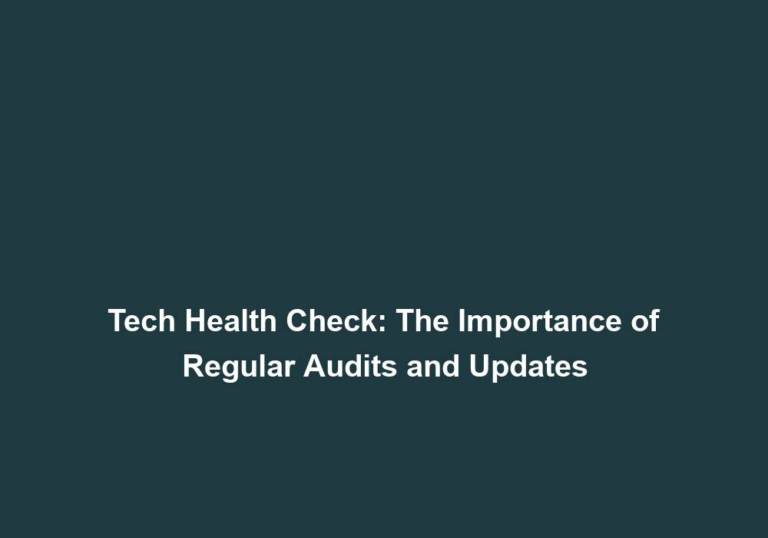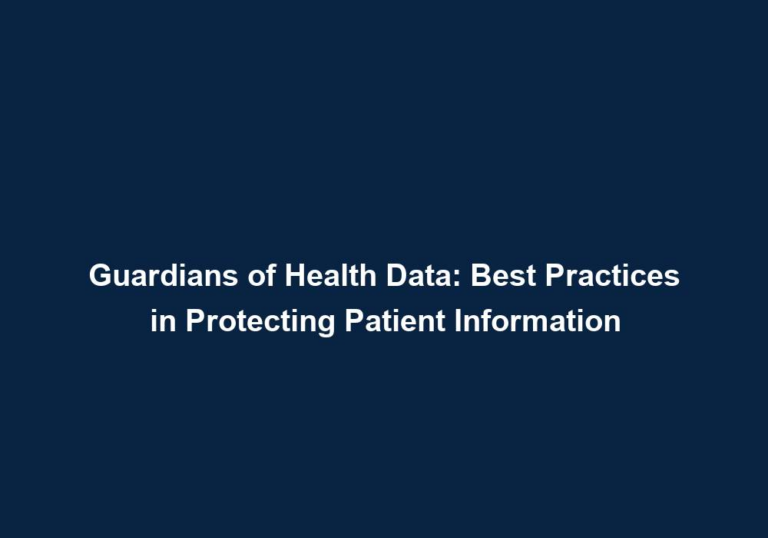Patch, Protect, Proceed: Regular Tech Audits and Updates in Healthcare
In today’s fast-paced digital world, technology plays a crucial role in the healthcare industry. From patient records management to medical billing, hospitals and healthcare organizations heavily rely on various software systems and devices to provide quality care. However, with the increasing prevalence of cyber threats, it is essential for healthcare providers to conduct regular tech audits and updates to patch vulnerabilities, protect sensitive data, and ensure a smooth workflow. This article will delve into the importance of these audits and updates and provide insights into best practices to keep healthcare systems secure.
The Importance of Regular Tech Audits and Updates in Healthcare
1. Protect Patient Data
In the healthcare sector, the protection of patient data is of utmost importance. Confidential medical records, insurance information, and personal details need to be safeguarded from unauthorized access and potential breaches. By conducting regular tech audits, healthcare providers can identify vulnerabilities in their systems and take necessary measures to patch them.
Here are a few reasons why protecting patient data is crucial:
- Data breaches can lead to identity theft and financial fraud, causing harm to patients and eroding trust in healthcare organizations.
- Healthcare providers have a legal and ethical obligation to ensure the privacy and security of patient information.
- Compliance with regulations, such as the Health Insurance Portability and Accountability Act (HIPAA) in the United States, requires the protection of patient data.
Regular updates to software and hardware ensure that security patches are applied promptly, reducing the risk of data breaches and keeping patient information safe.
2. Ensure Compliance with Regulations
The healthcare industry is subject to strict regulations, such as HIPAA in the United States, the General Data Protection Regulation (GDPR) in the European Union, and the Personal Information Protection and Electronic Documents Act (PIPEDA) in Canada. Compliance with these regulations is crucial to avoid penalties, legal actions, and damage to the organization’s reputation.
Here are some key reasons why healthcare providers must ensure compliance with regulations:
- Non-compliance can result in significant financial penalties and legal consequences.
- Compliance demonstrates the commitment of healthcare organizations to protecting patient privacy and complying with industry standards.
- It helps build trust with patients and other stakeholders, enhancing the organization’s reputation.
Regular tech audits help healthcare providers ensure that their systems and processes align with the necessary regulations. By staying up-to-date with the latest updates and security measures, organizations can demonstrate their commitment to protecting patient privacy and complying with industry standards.
3. Improve System Performance and Efficiency
Outdated software and hardware can significantly impact the efficiency of healthcare systems. Slow response times, system crashes, and compatibility issues can disrupt workflows and hinder healthcare professionals from delivering timely care. Regular tech audits provide an opportunity to assess the performance of existing systems and identify areas for improvement.
Here are some benefits of improving system performance and efficiency:
- Enhanced system performance allows healthcare professionals to access patient information quickly and provide timely care.
- Reduced downtime improves productivity and workflow efficiency, enabling healthcare organizations to deliver better services.
- Upgraded technology infrastructure can support new functionalities and advancements in healthcare practices.
Through updates and upgrades, organizations can optimize their technology infrastructure, resulting in enhanced system performance, reduced downtime, and improved overall efficiency.
Best Practices for Conducting Tech Audits and Updates
1. Develop an Audit Schedule
Creating a structured audit schedule is essential to ensure that tech audits are conducted regularly and consistently. Determine the frequency of audits based on the size of the organization, the complexity of systems, and the level of sensitivity of the data being handled.
Here are some considerations when developing an audit schedule:
- Allocate sufficient time and resources for conducting comprehensive audits.
- Prioritize critical systems and high-risk areas for more frequent audits.
- Stay updated with industry best practices and regulatory requirements to tailor the audit schedule accordingly.
A comprehensive audit schedule allows healthcare providers to proactively address security risks and stay ahead of potential threats.
2. Review Software and Hardware Inventory
Maintaining an up-to-date inventory of software and hardware is critical for effective tech audits. Regularly review the inventory to identify outdated or unsupported systems that may pose security risks. By keeping track of all technology assets, healthcare organizations can ensure that necessary updates and patches are applied to every device or software in use.
Here are some key steps to manage software and hardware inventory effectively:
- Document all software and hardware assets, including version numbers, licensing information, and support status.
- Regularly review the inventory to identify outdated or unsupported systems.
- Establish a process for tracking and updating software and hardware assets as new technologies are introduced.
By maintaining an accurate inventory, healthcare organizations can effectively manage updates and patches, reducing the risk of security vulnerabilities.
3. Conduct Vulnerability Assessments
To identify potential weaknesses in systems and networks, vulnerability assessments should be an integral part of tech audits. These assessments involve scanning the infrastructure for known vulnerabilities that could be exploited by malicious actors. Healthcare providers can then prioritize patching and updating efforts based on the criticality of identified vulnerabilities.
Here are some key steps to conduct vulnerability assessments effectively:
- Utilize vulnerability scanning tools to identify vulnerabilities in systems and networks.
- Prioritize vulnerabilities based on their impact and the likelihood of exploitation.
- Develop a remediation plan to address identified vulnerabilities promptly.
By conducting regular vulnerability assessments, healthcare organizations can proactively identify and address security weaknesses, reducing the risk of breaches and protecting patient data.
4. Implement Strong Authentication and Access Controls
Unauthorized access to sensitive patient information can lead to severe consequences. Implementing strong authentication mechanisms, such as multi-factor authentication, and access controls helps prevent unauthorized individuals from gaining access to healthcare systems. Regular tech audits should include an assessment of access controls to ensure that only authorized personnel can access sensitive data.
Here are some best practices for implementing strong authentication and access controls:
- Use multi-factor authentication to add an extra layer of security to user logins.
- Implement role-based access controls to limit access to sensitive information based on job responsibilities.
- Monitor and review user access logs regularly to detect any unauthorized access attempts.
By implementing strong authentication mechanisms and access controls, healthcare organizations can significantly reduce the risk of unauthorized access and protect patient data.
5. Educate Employees on Cybersecurity Best Practices
Human error remains a significant factor in cybersecurity breaches. It is crucial to educate employees about cybersecurity best practices and raise awareness about potential threats. Regular training sessions and workshops should be conducted to ensure that healthcare professionals understand their role in maintaining the security of the organization’s systems and data.
Here are some key points to consider when educating employees on cybersecurity best practices:
- Provide training on identifying phishing attempts, using strong passwords, and avoiding suspicious websites and email attachments.
- Reinforce the importance of reporting any security incidents or suspicious activities promptly.
- Conduct periodic refresher courses to keep employees updated on the latest cybersecurity trends and threats.
By educating employees on cybersecurity best practices, healthcare organizations can create a culture of security awareness and minimize the risk of human errors that can lead to breaches.
6. Stay Informed about Emerging Threats
Cyber threats evolve constantly, and new vulnerabilities are discovered regularly. It is essential for healthcare providers to stay informed about the latest threats and security measures. Subscribing to industry newsletters, attending cybersecurity conferences, and participating in information-sharing forums can help organizations stay one step ahead of potential cyber attacks.
Here are some ways to stay informed about emerging threats:
- Subscribe to cybersecurity newsletters and alerts from reputable sources.
- Participate in industry conferences and webinars focused on healthcare cybersecurity.
- Engage in information-sharing forums and collaborate with other healthcare organizations to exchange insights and best practices.
By staying informed about emerging threats, healthcare organizations can proactively adapt their security measures to mitigate risks and protect sensitive information.
Conclusion
Regular tech audits and updates are essential for healthcare providers to protect patient data, ensure compliance with regulations, and improve system performance. By following best practices such as developing an audit schedule, conducting vulnerability assessments, and implementing strong access controls, healthcare organizations can mitigate security risks and maintain the integrity of their technology infrastructure. Staying proactive and informed about emerging threats is key to safeguarding sensitive information and providing quality care in today’s technology-driven healthcare landscape.
Note: This article is written in markdown format.

